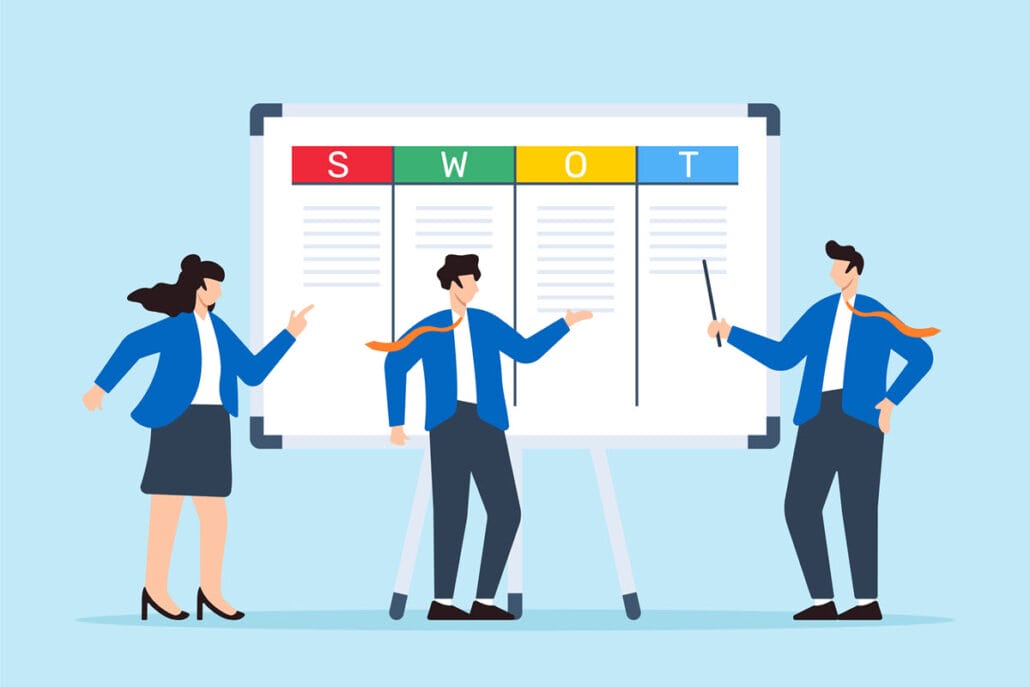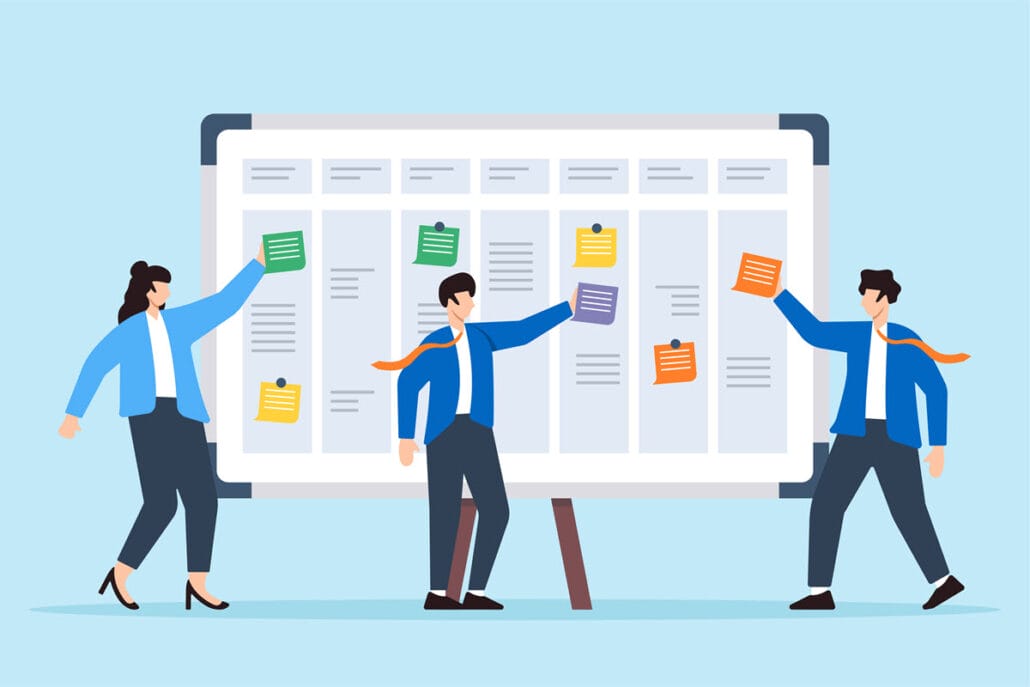What is strategic HR management and why is it crucial for business success? Strategic HR management aligns HR practices with an organization’s goals, turning HR into a strategic partner. In this article, we’ll explore how proactive strategies in talent management, workforce planning, and employee engagement drive long-term business success.
Key Takeaways
- Strategic Human Resource Management (SHRM) involves aligning HR practices with the overall business strategy to enhance productivity, employee engagement, and organizational success.
- Key components of SHRM include workforce planning, talent management, and employee engagement, all aimed at supporting long-term business goals.
- The strategic HR planning process should include working with organization leaders to align the human resource management strategy with the broader strategy of the business.
- Utilizing data analytics and AI in HR processes can improve decision-making, automate tasks, and measure the impact of HR activities on business performance, contributing to better overall efficiency.
Understanding Strategic Human Resource Management

Strategic human resource management builds a link between an organization’s business objectives and the employees tasked with achieving them. It aims to:
- Align HR practices with the overall strategic direction of the company
- Take a proactive approach to various HR processes, ensuring that HR activities are part of the company’s long-term objectives
- Help human resources make better decisions, improve productivity, reduce costs, increase profits, and enhance employee satisfaction
Engaging in SHRM enables HR personnel to contribute positively and directly to the company’s growth.
Benefits of Strategic Human Resource Management
With strategic human resources management, an organization’s human resources department is working to create processes that benefit the present and the future. It involves creating and executing HR programs designed to solve business challenges and support long-term business goals.
Unlike traditional HRM, which is task-oriented and reactive, strategic human resources management is proactive and integrated with strategic management, aiming to recruit and retain the right people.
Strategic HR recognizes key skills and competencies, undertakes talent needs analysis, and makes educated decisions about:
- Strengthening skills
- Reskilling and upskilling the workforce
- Hiring
- Outsourcing skills
This approach enhances HR practices to better support business performance and is crucial for continuous growth.
Strategic HR management can also offer major cost savings for the company. This in turn can open up budgets to help foster a more competitive working environment. For example, as part of a strategic initiative, organizations can focus on staying in front of trends or work on creating a better culture.
When successful, these strategic efforts often lead to more competitive benefits. The benefits can be offered to existing employees to aid in retention, and also help attract and recruit new employees. The cost savings from strategic leadership can be significant.
By aligning the activities of human resources with the organization’s long-term goals, strategic HRM helps sustain a changing business plan and unlock the full potential of each person in the organization.
Key Components of Strategic HR
The key components of strategic human resource management encompass:
- Workforce planning: Involves identifying future staffing needs based on business forecasts and aligning HR activities with the company’s long-term objectives.
- Talent management: Focuses on attracting, developing, and retaining top talent within the organization, ensuring a sustainable workforce with the required skills and competencies.
- Employee engagement: Includes creating a positive work environment and fostering a sense of commitment and loyalty among employees. Engaged employees are more productive, committed, and aligned with the company’s goals.
A comprehensive HR strategy also covers organizational culture and succession planning, which are integral to achieving HR and business success.
Developing and executing HR programs that address business problems and contribute to long-term goals is crucial for strategic HRM.
Grasping Strategic Human Resource Management

Strategic human resource management is about coordinating HR strategies with the organization’s objectives and promoting consistency in HR practices. This coordination is fundamental because it transforms human resources from a simple administrative function into a strategic partner crucial for business success.
Grasping SHRM requires HR professionals to take a proactive approach to various areas like recruitment, learning and development, and performance management. It not only attracts and retains top talent but also enhances employee productivity and satisfaction.
Since strategic human resource management aims to create value for customers, shareholders, employees, and other stakeholders, it provides the organization with a competitive advantage.
Acquring skills in the alignment of human resource management strategy, day-to-day HR practices, and overall business strategy contribute to the business’s success and fostering a sense of purpose in each stakeholder.
Aligning HR Strategy with Business Strategy

Formulating an HR strategic plan in line with the company’s objectives is crucial to propel organizational success.
A collaborative strategy involves asking questions about critical areas that will influence HR strategic planning initiatives, like:
- Required skills for new products or market expansion
- Changing business strategies
- Upcoming changes in leadership or organizational hierarchy
- Financial shifts that could impact compensation or benefits
- Company culture and changes in the business environment
- Industry changes that could impact overall business strategy
A SWOT analysis can also be conducted to understand the organization’s Strengths, Weaknesses, Opportunities, and Threats. A SWOT analysis will help uncover answers to some of the areas above, and bring more clarity to both leaders and human resources.
HR professionals should act as strategic partners in SHRM. This involves:
- Working closely with leaders and stakeholders
- Taking an ‘outside-in’ approach that considers the needs and expectations of external stakeholders such as employees, leadership, shareholders, investors, and customers
- Improving communication between leaders and employees
- Enhancing productivity
- Promoting employee engagement and retention
By aligning HR activities with business strategy, organizations can enhance their ability to anticipate and respond to customer needs, improve organizational communication, and promote employee engagement and retention.
HR Strategic Planning: Setting Objectives
As you just learned, establishing objectives for strategic human resource management requires a holistic understanding of the business’s primary strategic goals. Once the human resource department is well-versed in these goals and any changes that lie ahead, HR professionals can then develop corresponding HR objectives.
This process includes intra-departmental strategic planning within the human resources department to do the following:
- Outline the primary business objectives in the greater business strategy
- Identify what elements of the business strategy can be directly and indirectly impacted by human resources
- Create programs and policies that support business goals
By following these steps, HR departments can feel more confident in strategic decision making, know that their human resource strategy is working toward the greater goals of the organization.
Defining goals provides a framework for measuring success in strategic HR management. These goals break down into sub-goals and provide milestones in the planning process, ensuring that HR strategies remain aligned with business objectives.
Monitoring Performance Using KPI’s
A key aspect of linking HR programs to business outcomes is using data analytics to measure the impact of HR activities on business goals. This data-driven approach helps HR departments make informed decisions, anticipate potential challenges, and address them before they become critical issues.
Tracking performance using key performance indicators (KPIs) is vital to assess the efficacy of HR strategies. KPIs should align with the organization’s strategic goals and HR priorities, providing a framework for measuring success and identifying areas for improvement. Common HR KPIs include employee Net Promoter Score (eNPS), employee satisfaction index, and absenteeism rate.
Evaluating performance in strategic HR management involves:
- Comparing actual results to expected outcomes
- Assessing the impact of HR activities on business goals
- Measuring HR outcomes using metrics such as cost-per-hire, training effectiveness, and performance of new hires
By using these measures, organizations can ensure that their HR strategies are effective and contribute to better business performance.
Strategic HR Models and Strategies

Various HR models and strategies focus on the many aspects of HR management, including talent, concepts, and systems & processes. These models provide frameworks for aligning HR activities with organizational objectives and achieving competitive advantage.
By understanding and implementing these models, HR departments can enhance their strategic decision making and contribute to business growth and success.
Talent and People-Focused HR Models
Talent and people-focused HR models emphasize attracting, developing, and retaining top talent within the organization. Some talent management models aim to build a strong talent pool, reduce turnover, and ensure a sustainable workforce with the required skills and competencies. They highlight the importance of talent management and people development in achieving business success. By implementing people-first models, organizations can enhance employee performance, engagement, and retention, ultimately contributing to long-term business goals. Some examples of these models include:
- The 9-Box Grid Model which categorizes employees into nine groups based on two factors: performance and potential. The resulting matrix is used to align talent management and development strategies with areas where they can have the greatest impact.
- High-Potential Models focus on identifying employees with the drive, ability and motivation needed for senior-level positions.
- Succession Planning Models take a proactive approach that ensures a smooth leadership transition when key employees leave the business.
- Talent Pipeline Models involve finding, attracting, and engaging with candidates to meet not only the current needs of the organization, but those for future needs as well.
The People Value Chain Model is yet another example that demonstrates how focusing on talent and people development can create value for the organization.
Concept-Focused HR Models
Concept-focused HR models are based on core principles and concepts that guide effective HR management. The 8-box Model by Paul Boseli, for example, outlines eight interrelated factors that lay the foundations of an HR department. The Warwick Model, developed by Chris Hendry and Andrew Pettigrew, focuses on aligning HR activities with organizational objectives and external market conditions.
These models do not specify processes or roles but provide a framework for adapting HR practices to the organization’s needs. By implementing these models, HR departments can enhance their strategic approach and contribute to business growth and success.
System & Process HR Models
System and process HR models concentrate on creating efficient HR processes and systems to enhance overall human resource management. The High-Performance Work System Model, for example, focuses on aligning individual goals with business objectives and providing necessary support and resources to foster high performance and productivity. The Agile HR Model emphasizes flexibility, adaptability, and cross-functional collaboration in HR practices.
The Model of HR Roles by Dave Ulrich and the 5P’s Model are other examples of systems and processes HR strategies that focus on improving HR practices and promoting continuous learning and development.
These models highlight the many approaches that strategic human resources can take to establish processes that align with business success. By reviewing and implementing elements of these models during strategic planning, HR departments can enhance employee engagement, performance, and retention, ultimately contributing to long-term business goals.
Leveraging Technology in Strategic Human Resource Management

Utilizing technology in strategic human resource management can notably improve HR practices and decision-making. Data analytics and AI tools enable HR departments to make data-driven decisions, automate processes, and measure the impact of HR activities on business goals.
By incorporating technology into HR practices, organizations can improve efficiency, accuracy, and overall effectiveness in managing their workforce.
Data-Driven Decision Making
Data-driven decision-making encompasses the use of data analytics to make educated HR decisions and enhance organizational performance. HR departments can leverage advanced technology and data analytics tools to measure and track key performance indicators. These indicators can be related to workforce planning, talent management, and employee engagement. Predictive analytics can identify skills gaps, prioritize areas for skill development, and design targeted training programs.
Google’s Project Oxygen, begun way back in 2008, is an example of a data-driven approach to HR that has significantly improved team metrics, including turnover, satisfaction, and performance. The result clearly showed that teams with the best leaders were 5 to 18% happier than the average Google employee.
Regardless of the goal, by leveraging their own company’s data analytics, HR departments can anticipate and address potential challenges before they become critical issues. This ultimately contributes to better business performance.
AI in HR Processes
Incorporating AI in HR processes can simplify various HR functions and boost overall efficiency. AI-powered tools can automate repetitive tasks like screening resumes and scheduling interviews, significantly reducing the time and effort required for recruitment processes. It can also automate onboarding processes, ensuring smooth and positive experiences for new employees.
AI tools can be used in HR departments to:
- Design personalized learning and development programs based on employees’ skills and job requirements
- Enhance employee performance, retention, and engagement
- Contribute to the organization’s long-term goals
- Stay competitive and adapt to changing business environments
The strategic approach of using AI and other technology help streamline HR efforts, and allow organizations to stay competitive and adapt to changing business environments.
Best Practices for Implementing Strategic HR Management
The implementation of strategic HR management necessitates a holistic approach comprising regular workforce planning, promoting continuous learning, and efficient performance management systems. These best practices ensure that HR activities are aligned with the organization’s long-term goals and contribute to overall business success.
Regular Workforce Planning
Consistent workforce planning is essential to pinpoint future staffing needs grounded on business forecasts and to align HR activities with the company’s long-term objectives. Strategic HRM involves hiring based on future demands, not just immediate needs, ensuring that the organization has the right talent to achieve its goals. Workforce planning also includes monitoring workforce composition factors such as age, economic conditions, and globalization to effectively execute strategic plans.
Incorporating workforce planning into strategic discussions ensures alignment with long-term goals and helps prioritize training resources where they are needed most. By regularly assessing and adjusting the strategic HR plan, organizations can maintain a positive work environment, improve employee productivity, and enhance employee retention.
Fostering Continuous Learning
Fostering a culture of perennial learning and development within the organization is vital for professional growth and employee retention. Organizations can foster continuous learning by:
- Valuing and encouraging learning
- Recognizing and rewarding employees
- Facilitating knowledge sharing and collaboration
- Integrating learning goals into the performance management process
Offering continued education and professional development opportunities helps retain employees, as 94% state they would stay longer if the company invested in their growth.
By fostering a culture of continuous learning, organizations can enhance employee engagement, productivity, and overall business performance. Continuous learning ensures that employees have the skills and knowledge needed to adapt to changing business environments and contribute to the organization’s long-term goals.
Effective Performance Management Systems
Effective performance management systems align individual performance with company goals, driving the business forward by integrating individual goals with the larger business plan. This alignment promotes productivity, guides training and development initiatives, and helps avoid costly surprises. Clearly communicating performance expectations to employees, including goals, objectives, and key performance indicators, ensures that employees understand what is expected of them and how their performance will be evaluated.
Using performance metrics helps in objectively evaluating employee contributions, ensuring fair and consistent performance management. Regular feedback and coaching are critical components of a successful performance management system, as continuous feedback ensures that issues are addressed promptly and employees have the support they need to improve and succeed.
Evaluating and Updating HR Strategies
Assessing and updating HR strategies is essential to sustain their effectiveness and relevance to changing business needs. Regularly reviewing and refining HR strategies ensures that they continue to align with the organization’s long-term goals and contribute to overall business success.
Perpetual refinement of HR strategies involves frequent reassessment and fine-tuning of HR processes to guarantee that they meet organizational goals. Fostering a culture of continuous improvement helps organizations adapt to changing business environments and maintain a competitive edge.
Regular reviews of performance metrics and employee feedback are essential for driving continuous improvement in HR strategies and ensuring their effectiveness. By promoting continuous improvement, organizations can enhance employee engagement, productivity, and overall business performance.
This approach ensures that HR strategies remain relevant and aligned with the company’s long-term goals, contributing to organizational success.
Overcoming Challenges in Strategic HR Management
In strategic HR management, HR managers encounter diverse challenges such as talent acquisition, overcoming economic downturns, and formulating robust leadership teams. Effective change management is facilitated by strategic HRM, ensuring smooth transitions during organizational restructuring or technology adoption. Using established change management models can increase the likelihood of successful change.
Establishing a positive workplace culture is important for retention, as employees who feel unrecognized are twice as likely to seek new jobs. Competitive compensation and benefits packages are also critical in retaining high-performing employees. By addressing these challenges and implementing effective HR strategies, organizations can enhance employee engagement, retention, and overall business performance.
Examples of Successful Strategic HR Management
Real-life examples of successful strategic HR management provide valuable insights into how organizations can effectively implement SHRM practices. Companies like Google and Starbucks have demonstrated the positive impact of strategic HR initiatives on business outcomes and employee engagement.
Case Study: Google
Google places a high emphasis on strategic HR initiatives to foster an innovative work environment. One notable initiative noted earlier in this article is Project Oxygen. The data first discovered that top performing managers made their team members happier employees. It then went on to explore what traits make those managers the top-performers that they are. The study identified ten key traits of top-performing managers, including collaboration and effective communication. By focusing on these traits, Google ensures that its HR leaders can inspire innovation and effectively retain top talent, contributing to the company’s long-term goals and business outcomes.
In addition, Google’s data-driven approach to HR has significantly improved team metrics, including turnover, satisfaction, and performance. By leveraging data analytics and aligning HR activities with business strategies, Google has created a positive work environment that promotes employee engagement and productivity, ultimately driving organizational success.
Case Study: Starbucks
Starbucks focuses on employee engagement and development as part of its strategic HR plan to foster innovation and retain talent. The company has implemented comprehensive training programs and career development opportunities for employees, ensuring that they have the skills and knowledge needed to succeed in their roles. By investing in employee development, Starbucks enhances employee satisfaction and retention, contributing to the company’s long-term goals and business outcomes.
Starbucks’ strategic HR initiatives have helped create a positive work environment that encourages innovation and collaboration. Some of these initiatives include:
- Aligning HR activities with business strategies
- Focusing on employee engagement
- Providing opportunities for growth and development
- Offering competitive compensation and benefits
- Promoting diversity and inclusion
By implementing these initiatives, Starbucks has demonstrated the importance of employee engagement in achieving business success and driving organizational growth.
Summary
Strategic human resource management involves aligning HR activities with business goals, leveraging technology, and implementing best practices. By understanding the core components of SHRM, setting strategic objectives, and linking HR programs to business outcomes, organizations can enhance employee performance, engagement, and retention. Real-life examples from companies like Google and Starbucks demonstrate the positive impact of strategic HR initiatives on business success.
Continuous improvement and regular evaluation of HR strategies are crucial for maintaining their effectiveness and relevance to evolving business needs. By fostering a culture of continuous learning, promoting effective performance management systems, and addressing challenges in SHRM, organizations can achieve long-term business goals and drive organizational growth. Embrace these strategies and take your HR management to the next level.


